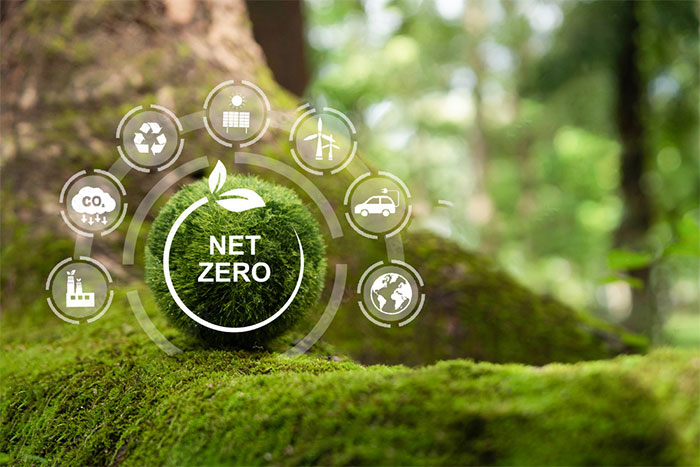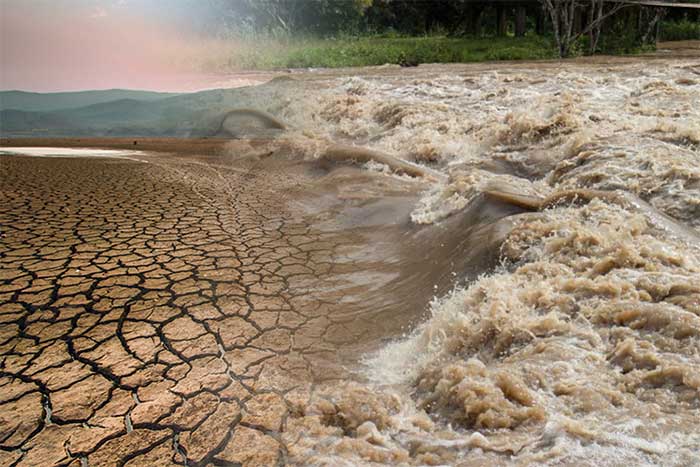What is Net Zero? If Net Zero is not implemented, what will the Earth look like?
Vietnam and the whole world are aiming for Net Zero by 2050. This is a term that is mentioned often but is perhaps unfamiliar to many people. Let's find out what is the meaning behind Net Zero?
Science has proven that greenhouse gases emitted by humans are the cause of global warming, which has caused many consequences for humanity and future generations. Recognizing the dangers of greenhouse gas emissions, the United Nations has set a global Net Zero target.

Net Zero is the common goal of humanity today.
Net Zero concept
Net-zero is understood as cutting greenhouse gas emissions as close to zero as possible , with the remaining emissions reabsorbed from the atmosphere by forests and oceans.
Currently, the Earth has increased by 1.1 degrees Celsius compared to the late 1800s. To achieve the target of limiting the increase to only 1.5 degrees as required in the Paris Agreement on climate change (COP 21) in 2015, the world must reduce emissions by 45% before 2030 and achieve net zero emissions by 2050. Since then, the Net Zero goal has been born .
If Net Zero is not implemented, what will be the consequences for the Earth?
At the time the 2015 Paris Agreement was signed, many fossil energy giants opposed the 1.5°C target to the end, because fossil fuels were a lucrative source of revenue during the period. This. However, reports from the Intergovernmental Panel on Climate Change (IPCC) have shown that if emission levels continue to increase uncontrollably , the Earth could become warmer. level 2°C, even reaching 4 - 5°C. This is an extremely dangerous scenario for the survival of humanity .

Natural disasters may occur more intensely.
Global warming will change the climate including air, water, ice, soil and biota. Warmer temperatures in the atmosphere create more water vapor, causing heavy rain, storms, and floods. Meanwhile, prolonged heat will increase drought and water scarcity. In general, climate change makes natural disasters more severe and severe.
Prolonged heat is considered a health hazard to humanity , especially children, the elderly, outdoor workers, the poor. This group of people can suffer from heat stroke, heat stroke or heart disease. heart disease, more severe cases can cause death. Statistics show that in almost every severe heat wave, there are cases of death due to heat stroke.
In addition, air quality also deteriorates as Earth's temperature increases. At this time, the ozone layer thickens, the photochemical smog becomes thicker, and the air gets dirtier due to emissions from human activities.
Melting ice is also a difficult problem when the Earth's temperature increases. Currently, temperatures in the Arctic are increasing twice as fast, causing ice to melt faster. Melting ice causes sea levels to rise and can lead to sea water penetrating deep into the mainland, many islands and low-lying areas will be at risk of being submerged.
As emissions increase, sea water will become more acidic because it absorbs directly from emissions. Increased acidity levels will put marine life at high risk of extinction, such as crustaceans such as crabs, shrimp. or coral. In addition, when the Earth's temperature increases, terrestrial animals must change their behavior to avoid heat or else they will become extinct if they cannot adapt in time.
It can be seen that the Earth's temperature has a great impact on human survival . To achieve moderate temperatures, the world must control net emissions to zero. That is why the Net Zero goal has increased in importance.

Two opposing states of a warming Earth and a temperate Earth. Which planet you choose is your action from now on.
How can Net Zero be achieved?
Transitioning to a net zero emissions world is one of the biggest challenges humanity faces. It requires nothing less than a complete transformation of the way we produce, consume and move. The energy sector is the source of about three-quarters of current greenhouse gas emissions, and therefore plays a key role in preventing the worst impacts of climate change. Replacing polluting coal, gas and oil thermal power with energy from renewable sources, such as wind or solar, will significantly reduce carbon emissions.
- Implement renovation and restoration of Tam hoa plum varieties
- Inaugurated a rare earth research center in Hanoi
- Europe launched 5 global observation satellites
- Chinese ships paired with the module for the second time
- NASA: Deflect meteorites with nuclear weapons
- 10 interesting facts about Earth you may not know
- In the universe does not transmit sound, so what do astronauts talk about?
- The Earth may have swallowed its planet
- The 8 biggest mysteries about Earth
- History and meaning of Earth Day
- Scientists think that these are the eight most likely cases of life eradication
- Video: Discover everything about Earth
 Is the magnetic North Pole shift dangerous to humanity?
Is the magnetic North Pole shift dangerous to humanity? Washington legalizes the recycling of human bodies into fertilizer
Washington legalizes the recycling of human bodies into fertilizer Lightning stone - the mysterious guest
Lightning stone - the mysterious guest Stunned by the mysterious sunset, strange appearance
Stunned by the mysterious sunset, strange appearance